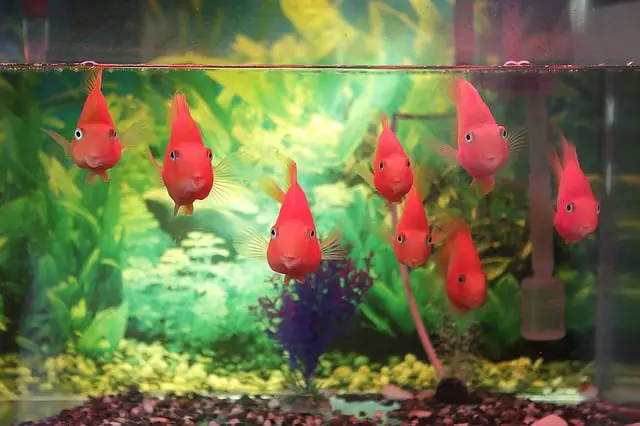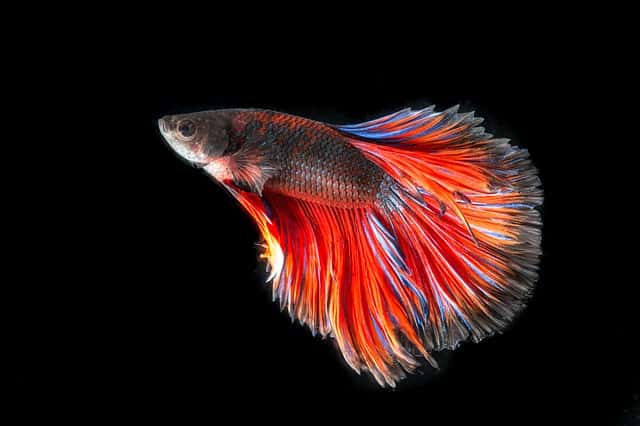If you’re new to marine tanks, then you probably aren’t familiar yet with saltwater protein skimmers – but have perhaps heard of them and are curious about them. I would have to say that a protein skimmer is a must-have in a saltwater tank, that is, if you want the healthiest tank possible for your fish.
Saltwater tanks should have a protein skimmer connected to maintain a healthy water environment. Protein skimmers clear organic compounds out of aquariums before it has the chance to break down in the tank, increasing nitrate levels.
I would imagine that there are saltwater fish tank owners that don’t have a protein skimmer and their water is just fine. I would have to say, however, that they are probably doing more work to maintain the quality of water than if they just hooked-up a protein skimmer.
In this article, I’ll talk about how a protein skimmer makes maintaining a saltwater tank easier and less work along with other great ‘take away’ information for you.
Let’s begin!
What is the Purpose of a Protein Skimmer?
A protein skimmer removes organic compounds such as poop and food left by the fish. The skimmer removes these particles from the tank before they have a chance to break down and increase ammonia, nitrites, and nitrates. At high levels, these compounds are dangerous to your fish.
A protein skimmer makes the filtration system work more efficiently by cleaning these compounds out of the fish tank prior to them breaking down in the aquarium.
This also means the water parameters are consistent and thus, in turn, promotes a much healthier water environment for the inhabitants of the tank. Less fluctuations in ammonia, nitrite, and nitrate is what you want to see in a saltwater aquarium.
The other huge bonus when using a protein skimmer is you won’t have to perform water changes as often. You will focus more on just topping up the tank. Of course, there’ll be general maintenance, like vacuuming substrate which is something you can’t avoid. A protein skimmer won’t pick everything up!
How Does a Protein Skimmer Work?
This is such a simplistic process and yet, is so valuable to the health of your tank’s water. Keep reading because I have a real-world example of protein skimming at the end of this section.
- Protein skimmers draw water into a chamber where it infuses tiny air bubbles into the water.
- The tiny air bubbles catch tiny organic compounds that are floating in the water.
- The air bubbles rise-up in the protein skimmers chamber, bringing along with them the organic compounds.
- As the bubbles rise-up into the cup at the top of the chamber, the bubbles pop and the organic compounds accumulate in the cup until they are emptied out.
It’s really that simple, yet such a valuable piece of the puzzle when maintaining a healthy saltwater aquarium.
A real-world example is how the ocean performs this process naturally. Have you ever walked on the shoreline of the ocean and noticed areas with a foam like substance?
Have you noticed how dirty those bubbles look? The dirt on the bubbles are organic compounds from the ocean.
When the ocean water is agitated at the shoreline by waves and air, it goes through the same process of an aquarium protein skimmer. As bubbles are created near the shoreline, organic compounds are then captured on the bubbles and brought to shore where they pop and leave the organic materials on the sand. Pretty amazing if you ask me!
Types of Protein Skimmers for Saltwater Tanks
There are many types of protein skimmers available for your saltwater tank.
I have personally used internal and hang on back style skimmers. Both styles worked great for me however, I found the hang-on-back easier when it came to maintenance. The one drawback from the hang-on-back skimmer was that it was noisier than the internal protein skimmer.
This hang-on-back style protein skimmer is an excellent choice for most saltwater tank owners with smaller tanks. It’s available through Amazon.
For the saltwater tank owners that have a sump running and/or just a huge salt tank, you can opt for a sump protein skimmer or an external protein skimmer.
The sump skimmer will sit in the sump, which means it won’t be sitting out in your tank visible. For anyone with a very large tank – say 300 gallons, for example – you could connect an external protein skimmer which would work similar to a canister filter. It’s a freestanding unit that draws in water to skim and then pushes back the water.
This sump style protein skimmer is an excellent choice for most saltwater tank owners. It’s available through Amazon.
Most people with larger tanks will do just fine with a sump protein skimmer. Just remember when selecting a skimmer to add your tanks gallons and sumps gallons together to figure out how big of a unit you require. So, if the tank is 150 and your sump is 30, you would need a skimmer rated for at least 180 gallons.

Does a Protein Skimmer Remove Nitrates?
Protein skimmers do not remove nitrates. However, by removing organic compounds, skimmers remove the precursor to nitrates (organic compounds).
Think of a protein skimmer as a fish tank device that cleans things up before water parameters get out of control.
The best way to remove nitrates is to perform a water change. Regular water changes should be a part of your regular fish tank maintenance. This way, you never have to worry about nitrate issues.
When Should You Add a Protein Skimmer?
A protein skimmer can be added to a saltwater tank immediately upon setting it up – meaning, you can run it during the nitrogen cycle.
Although, when you are first cycling a saltwater tank, there really isn’t much (if anything) organic floating through the water.
When you start adding fish food and your fish start pooping, then that’s the optimal time to install a protein skimmer.
That said, adding the skimmer before you add fish and food is a good idea as it sometimes takes a bit of tweaking to adjust the water flow and bubble strength in order to get the skimmer function properly and efficiently.
Should You Run a Protein Skimmer 24/7?
You don’t necessarily need to run a protein skimmer 24/7 because of the way the device functions.
A skimmer creates tiny bubbles so tiny bits of organic compounds can attach to them. It’s not like the skimmer needs to run for a long period of time to be effective.
In theory, that probably sounds great because now you’re thinking you can have the skimmer running at times when you won’t be bothered by the noise it makes.
There is an issue, however, when you turn the skimmer on and off. I know this from experience of using one whereas someone new to using a protein skimmer wouldn’t have a clue.
The issue is you’ll need to fine-tune the water and air flow (bubbles) almost every time you turn the skimmer off and on again.
Does a Protein Skimmer Oxygenate the Water?
The main function of a protein skimmer is to remove organic matter by adding bubbles to the saltwater tank (within the filter).
So yes, a protein skimmer oxygenates the water. Not just because of the oxygen the skimmer is infusing in the water, but by the agitation of the surface that occurs because of the protein skimmer functioning.
Will a Protein Skimmer Help with Algae?
You bet it will help with algae control. Because the skimmer removes organic compounds before they can break down, this lessens the chances of algae forming. Regular tank maintenance (including cleaning) will also help keeping algae levels low.
Do You Need a Filter if You Have a Protein Skimmer?
Yes, you still need a filter running even when you have a protein skimmer running on your saltwater tank.
Filtration cleans debris out of the tank along with providing a place for beneficial bacteria to grow.
When you add carbon to the filter, it’ll then perform what is called chemical filtration. Activated carbon will strip the water of toxins and medicines. I don’t recommend using carbon filtration, unless you want to really strip the water of everything. This can be good, but it can also be bad – it just depends on your tank’s needs at the time.
How Often Should You Clean Your Skimmer Cup?
Skimmer cups are where the tiny bubbles pop leaving organic compounds to be collected.
Skimmers will have different sized cups, therefore will need to be emptied at different times.
Until you get used to how your skimmer works, I’d recommend keeping an eye on it a couple times a day to see if it’s filling up quickly or not.
The dirtier your tank is, the more often you will need to empty the skimmer cup. The cleaner your tank is, the less often you will need to empty the skimmer cup.
Conclusion
In conclusion, I just wanted to reiterate the importance of using a protein skimmer.
You can have success with a fish-only saltwater tank not running a skimmer however, your water quality won’t be as good as if you had used one.
Your fish will be healthier and happier and that’s really what this fish keeping hobby is all about, isn’t it?
Also, your water will be sparkly clean using a skimmer!
Good luck!
Related Posts
HOB VS Canister Filter – Which is Best for You?
Surface Skimmer VS Protein Skimmer – What’s the Difference?
Do Saltwater Tanks Need Air Bubbles?
Do Aquariums Use a Lot of Electricity?
Why is My Saltwater Tank Cloudy?






